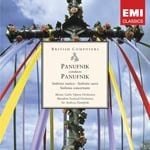3(III=picc).2.corA.2.bcl.2.dbn-4(6).4.3.1-timp.perc(3):SD/TD/BD/tam-t/cyms(lg)/susp.cym(sm)/2tgl(sm,lg)-strings
Abbreviations (PDF)
Boosey & Hawkes
Sinfonia Sacra, my third symphony, was composed as a tribute to Poland's Millennium of Christianity and Statehood, and as an expression of my religious and patriotic feelings. Because of the source of inspiration, I wanted this composition to be very much Polish in character and also to emphasise the Catholic tradition so deeply rooted in the country of my birth. Therefore I based Sinfonia Sacra on the first known hymn in the Polish language, the Bogurodzica, a magnificent Gregorian chant. Through the Middle Ages, Bogurodzica, like a national anthem, was sung not only in church as a prayer to the Virgin, but also as an invocation on the battle-fields by the Polish knights. Both these factors, heroic and religious, I have endeavoured to incorporate into my symphony, stressing their emotional power. Therefore, without reading too much literary, programmatic meaning into the music, the listener might still feel the atmosphere of the battlefield and of prayer, these two persistently repeated elements having dominated Polish life throughout all the thousand years of its tragic history.
Again, as in all my work, my emotional involvement with my chosen themes imposed for me the musical form. The symphony has two parts: Three Visions and Hymn. The Visions strongly oppose each other: Vision I - the colloquy between the four trumpets represents a solemn and extended fanfare to the symphony, Vision II - strings alone are used to create a mystic and contemplative atmosphere; Vision III - a dramatic tutti in which I wanted to create an interweaving conflict, mounting in agitation and protest, until a sudden cut brings complete silence . . . followed by the second part of the symphony, the Hymn.
The Hymn has the character of a simple prayer to the Virgin, which would express adoration and warmth. It starts pianissimo with strings' harmonics, growing gradually into a more and more ardent invocation until at last the full melody of the Bogurodzica finally breaks through, for the first time heard in its full melodic line, at which point the trumpets round the orchestra repeat their summons from the first Vision, bringing Sinfonia Sacra to a climactic end.
The three Visions are based on the intervals between the first four notes of the Bogurodzica melody: a minor second in Vision III, a major second in Vision II, and a fourth in Vision I. Thus, each Vision has its own 'basic sound'. (In Vision III in fact I have added a diminished fifth for the purpose of contrast and heightened expression.) Although I intended this symphony to be emotionally very highly charged indeed, all of its component elements are contained within an extremely rigid design.
Andrzej Panufnik
Reproduction Rights
This programme note can be reproduced free of charge in concert programmes with a credit to the composer

Sinfonia Sacra / Sinfonia Rustica - Monte Carlo Opera Orchestra
Sinfonia Concertante - Menhuin Festival Orchestra
Conductor: Panufnik
EMI Classics 3522892
